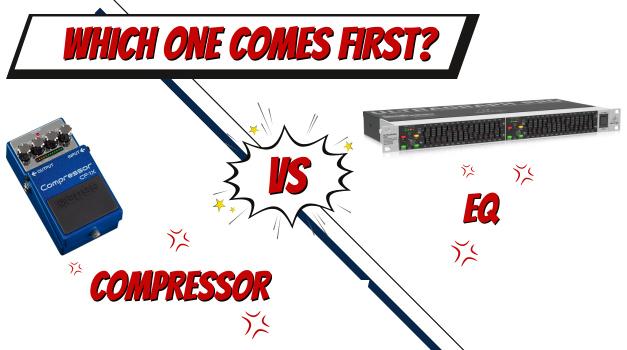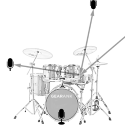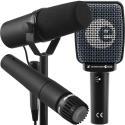EQ Before Or After Compression - Chicken or the Egg?

Equalizing is a well-known form of music processing, but should you apply EQ before or after compression?
This is a question many musicians, sound engineers, and producers ask themselves. However, the answer is not as complex as you think. Ultimately, it comes down to which option you prefer - so you just have to know the difference.
Here I will explain the effects of equalizing your mixing track before and after applying compression. This way, you can understand the effects and use EQ to get your desired results.
Understanding EQ And Compression
First, I want to touch on EQ and compression so we are all on the same page.
What Is EQ?
EQ stands for equalization. It is audio manipulation to help all the elements of a track to work together.
It can boost or cut the volume level of just a single frequency (or a range of frequencies if you prefer) to cure imbalances in the track.
You can trim unwanted frequencies or boost others to balance your sound. And you can do so more precisely with parametric EQ, low and high pass filter controls. With it, you can prevent excessive high-end "hissing" and clean up the low end.
EQ is done by adjusting the gain controls of each frequency range. Gain reduction (subtractive EQ) means lowering the volume of the frequency range. While increasing gain boosts them.
EQ plug-ins are used for tone shaping, and to clean up individual tracks or the overall mix.
What Is Compression and Dynamic Range?
Compression is another type of audio manipulation that affects the dynamic range of a mix, which refers to the degree of volume changes of an audio signal.
An audio compressor device adds compression on the loudest parts of the waveform of an audio signal until it meets a fixed compressor threshold. Essentially, you are limiting the dynamics of a sine wave.
Compression avoids clipping and distortion in audio, so it sounds more transparent and cleaner. Some compressors come with makeup gain for bumping up the volume of the compressed audio signal.
Vocal compression is a crucial process done in recordings. More compression can also be used creatively to add punch and kick to a mix. This is why a lot of guitars are hooked up to compressor pedals, to make clean riffs more snappy and in your face. A compressor generates extra harmonics as well, which works well with distortion. Since compressed signal sounds clean and don't clip, they are ideal for recording situations.
The Effects Of EQ Before or After Compression
So, now you understand EQ and compression a bit better, let's dive into the effects they have on your tracks.
EQ Before Compression
Using an equalizer before your audio signal hit the compressor (pre compression) can help remove an unwanted frequency from your audio.
By removing the frequency content you don't want, you can increase the loudness of the frequency you do want. However, it will all get squashed together through the compressor.
What you will hear is a more unified recording that is warmer and rounder. Mixes that were equalized before being compressed tend to have smoother upper midrange and low end.
There is a downside to this method. If you want to remove or boost elements of your audio, you will need to recalibrate your compressor. When dealing with excessive vocal S sounds, use a deesser.
EQ After the Compressor
Equalizing your music post compression allows you to have more control over the resulting sound. EQ modifies the compressed sound, so it's less work to add any boost and easier to make certain elements stand out - like making the vocal track more upfront, over the kick drum and bass.
Basically, equalizing the whole mix after being compressed results in greater clarity of sound. This is why it makes sense to use a second EQ for fine-tuning the master bus.
Final Thoughts
So, whether or not you should put the EQ before or after compression is down to personal preference. There is no hard and fast rule - whichever choice you make depends on your preferred compression sounds.
If you want to achieve a warmer tone, you should equalize before you put the signal chain through the compressor. Doing active EQ on a bass guitar before applying compression is a common example of this configuration. If you want the overall mix to sound tighter, compress the signal first and then play with the EQ settings.
The real answer to the question is that there is no right or wrong way. You cannot immediately hear the difference, so you'll need to try the EQ before or after compression before you choose which method to use. Knowing how different configurations affect mixes will give you a good idea of what your mixes are calling for.












